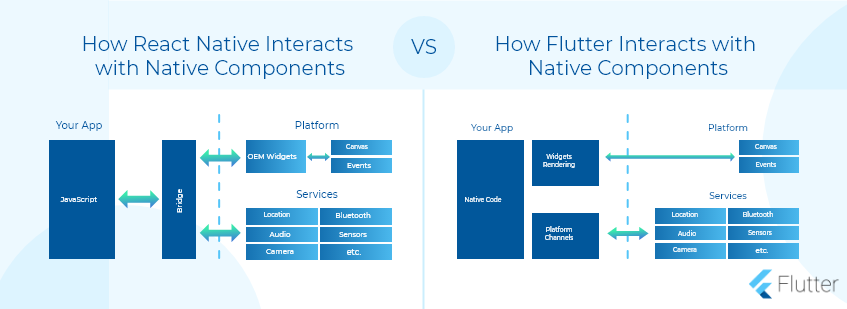Flutter is Google’s UI toolkit, a cross-platform framework which empowers businesses to develop beautiful, natively compiled applications from a single code base, eliminating the need for separate coders for Mobile (iOS, Android), Web, Desktop and Embedded.
The other unique things about are:
- It is at a nascent stage; its stable version was released on December 4th 2018.
- It is open-source; so, anyone can use it.
- Dart: It is based on Dart language, developed and introduced by Google in 2011.
- Widgets: A large army of highly customizable widgets empower Flutter. Making an app is similar to building a Lego, putting it all in place piece by piece.
- Dedicated UI Rendering Engine: Skia
Flutter uses Skia as its cross-platform rendering engine and is the reason that its UI can be applied on any platform, without the need to tinker with UI - C/C++ Library, Better Native Performance:
Flutter gives better native performance because its applications are compiled in C/C++ library which is near to machine language and thus is a better performant
![]()
The Competition
There are various native platforms like Android Studio, Apple Xcode, Swift, which require separate coding and have forced developers to seek cross-platform solutions like Xamarin, React Native and Apache Cordova. Flutter directly challenges the supremacy of Facebook’s React Native as the preferred cross-platform application development framework.
Flutter Vs React Native
- Performance
As React Native uses a JavaScript bridge to convert its widgets to OEM widgets, there is a drop in performance as a result of constant conversion. Flutter does not use a bridge, resulting in a fast, smooth and stable UI performance. This also gives it the compatibility with between versions ex. Kitkat and pie etc., as it is not affected by UI/UX changes. - Native Component and API:
For ultimate performance, the framework must have access to native modules with ease. React Native is heavily dependent on third-party libraries; Flutter, on the other hand, comes with UI rendering components, abundant libraries, and device access APIs etc. which ensure better performance. - UI Component:
One major difference is that Flutter gives natural platform feel due to Material Design (Android) and Cupertino (iOS) widgets, allowing it to imitate the platform design itself. React Native, on the other hand, requires third-party libraries to achieve the same. - Time-to-market:
The presence of a bridge and native elements in React Native results in the need for separate optimization for different platforms. This may result in a longer development time. Flutter, on the other hand, does not run into these problems because of its widget-based design. - Support for Testing:
There are no officially supported tools for testing in Native React, only third-party tools like Detox & Appium are available. In contrast, Flutter comes with an enriched set of widget testing features at various levels such as at unit, widget and integration stage. - Ecosystem:
Without a doubt, React Native has a mature and rich ecosystem with over 5 times the number of packages as in Flutter; Flutter, though is catching up fast.

There are many other parameters on which Flutter and React Native can be compared. But overall flutter seems to enjoy the lead.
Flutter Advantage for Businesses
- Cost-Effective:
Flutter uses significantly fewer human resources, material and time, for developing apps across platforms. - Beautiful UI/UX:
The inherent quality of Flutter to produce beautiful UI/UX and accommodate to any platform is amazing. - Business Logic and UI Across Platforms:
None of the applications except Flutter permits sharing of UI code as well as UI. This rendering process results in native looking app irrespective of the platform. Flutter makes it possible to share Business logic as well as UI, resulting in the saving of a lot of time and effort. - Less Development Time with Hot Reload:
A large volume of highly customizable ready-to-use widgets in Flutter cut short the development time. The “hot-reload” feature saves a lot of time as it shows the effects of changes in real-time. This is achieved by injecting the latest code into Dart Virtual Machine (VM), making changes visible within seconds. - Easy UI Customization at Any Complexity
While customization of UI can be done on other platforms, the effort required varies with the task. Flutter eliminates the subjectivity and makes the customization process quite flexible and extensive, but with no incremental workload. - Fuchsia OS, Google’s new OS is based on a microkernel called Zircon and has been developed to power the millions of IoT devices that will envelop our lives in future. Fuchsia comes with the capacity to run on all devices, and Flutter will be used to develop applications for these millions of devices. Hence it becomes vital for businesses to switch to Flutter. Please follow our next blog on Fuchsia OS for more detailed insights.
- The Startup Advantage:
For startups with a shoestring budget, but who want to use technology, Flutter with its easy to learn framework, low cost of development and faster time-to-market is a blessing; it also gives them ample scope to experiment and innovate.
Flutter, a Step Away from Native
Flutter comes with significant advantages over native platforms, and also over React Native. It creates value by reducing development time, cost, and gives better performance vis-a-vis React Native; though its ecosystem is small when compared with React Native but is growing exponentially.
The switch to flutter can be argued from a futuristic perspective as well; Fuchsia OS, which will power billions of devices in the future shall have its applications in Flutter. Startups shall also find Flutter of great help for obvious reasons. From every angle, switching to Flutter is a cogent argument.
 All Posts
All Posts